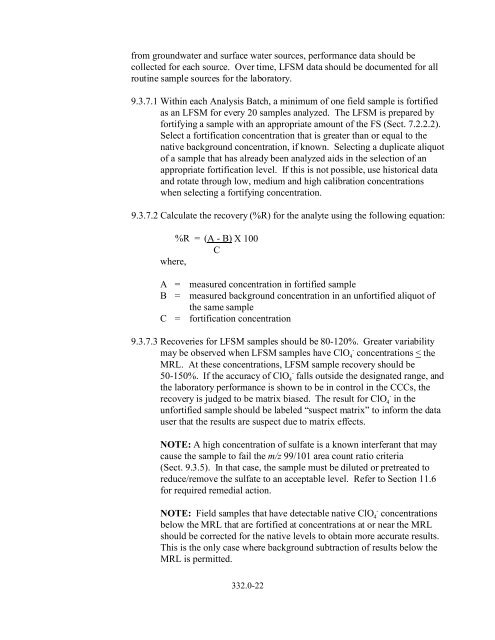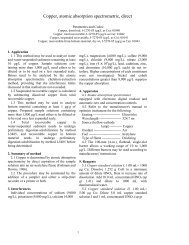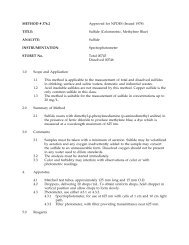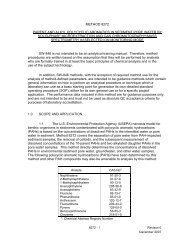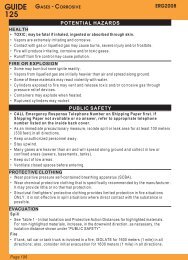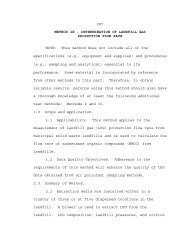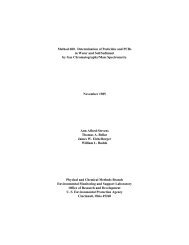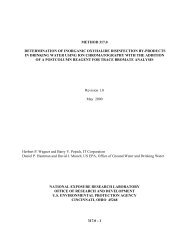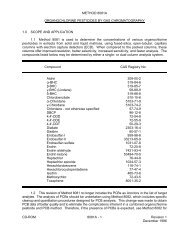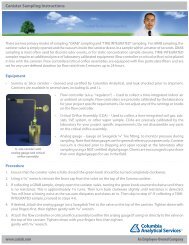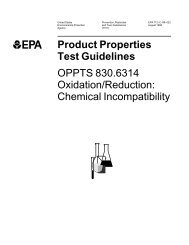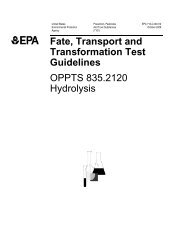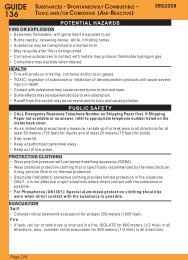View Actual EPA Method 332 (PDF File) - Columbia Analytical ...
View Actual EPA Method 332 (PDF File) - Columbia Analytical ...
View Actual EPA Method 332 (PDF File) - Columbia Analytical ...
Create successful ePaper yourself
Turn your PDF publications into a flip-book with our unique Google optimized e-Paper software.
from groundwater and surface water sources, performance data should be<br />
collected for each source. Over time, LFSM data should be documented for all<br />
routine sample sources for the laboratory.<br />
9.3.7.1 Within each Analysis Batch, a minimum of one field sample is fortified<br />
as an LFSM for every 20 samples analyzed. The LFSM is prepared by<br />
fortifying a sample with an appropriate amount of the FS (Sect. 7.2.2.2).<br />
Select a fortification concentration that is greater than or equal to the<br />
native background concentration, if known. Selecting a duplicate aliquot<br />
of a sample that has already been analyzed aids in the selection of an<br />
appropriate fortification level. If this is not possible, use historical data<br />
and rotate through low, medium and high calibration concentrations<br />
when selecting a fortifying concentration.<br />
9.3.7.2 Calculate the recovery (%R) for the analyte using the following equation:<br />
%R = (A - B) X 100<br />
C<br />
where,<br />
A = measured concentration in fortified sample<br />
B = measured background concentration in an unfortified aliquot of<br />
the same sample<br />
C = fortification concentration<br />
9.3.7.3 Recoveries for LFSM samples should be 80-120%. Greater variability<br />
may be observed when LFSM samples have ClO 4- concentrations < the<br />
MRL. At these concentrations, LFSM sample recovery should be<br />
50-150%. If the accuracy of ClO 4<br />
-<br />
falls outside the designated range, and<br />
the laboratory performance is shown to be in control in the CCCs, the<br />
recovery is judged to be matrix biased. The result for ClO 4<br />
-<br />
in the<br />
unfortified sample should be labeled “suspect matrix” to inform the data<br />
user that the results are suspect due to matrix effects.<br />
NOTE: A high concentration of sulfate is a known interferant that may<br />
cause the sample to fail the m/z 99/101 area count ratio criteria<br />
(Sect. 9.3.5). In that case, the sample must be diluted or pretreated to<br />
reduce/remove the sulfate to an acceptable level. Refer to Section 11.6<br />
for required remedial action.<br />
NOTE: Field samples that have detectable native ClO 4- concentrations<br />
below the MRL that are fortified at concentrations at or near the MRL<br />
should be corrected for the native levels to obtain more accurate results.<br />
This is the only case where background subtraction of results below the<br />
MRL is permitted.<br />
<strong>332</strong>.0-22


